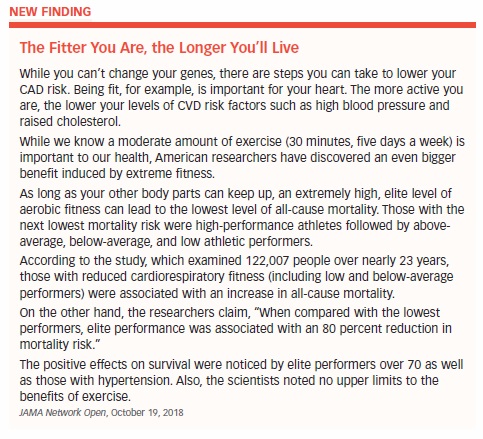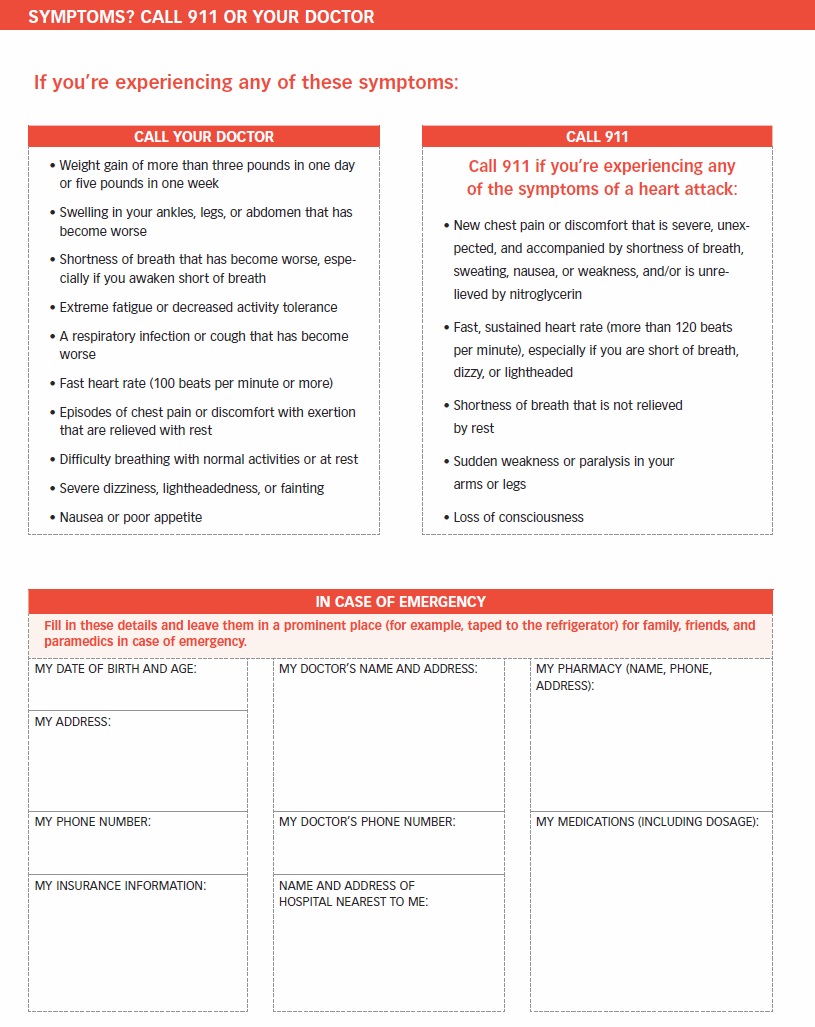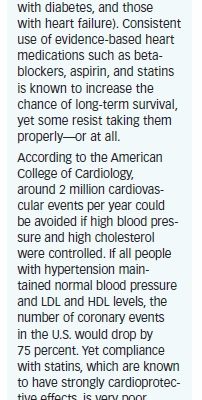7. Looking Ahead
Coronary artery disease is responsible for the deaths of 370,000 Americans annually. Fortunately, exciting advancements have entered the scene to help diagnose, treat, and prevent CAD.
One factor in the fight against the disease: New medications that limit the damage it causes. These drugs may reduce recuperation and recovery times. This means patients will be able to continue with their lives and activity levels more quickly than in the past. And over the next several years, you’ll likely see:
- Medications to delay or prevent the need for more extensive (and expensive) treatment.
- Medications that can reverse CAD.
- Medications that can stop or dramatically limit the damage from a heart attack.
- A more personalized approach using genetics to determine CAD risk and to predict the usefulness of certain medications in a patient.
- More emphasis placed on quality of life and the role of psychosocial factors in heart disease.
While new approaches are currently being tested in clinical trials, science is looking at different ways to improve heart surgery, reduce damage from heart attack, and, ultimately, prevent CAD.
Reducing Inflammation
Inflammation—your body’s way of warning you that something bad is going on—is another area garnering attention. While there’s no conclusive proof that inflammation causes heart disease, it’s a common condition experienced by those with CAD and those with stroke as well. When your arteries are filled with plaque, they become inflamed.
Statins, with their LDL-lowering effects, have long been touted as inflammation busters.
Canakinumab is a monoclonal antibody that reduces inflammation but has no effect on cholesterol or other blood lipids. A trial of 10,000 people with prior heart attack and systemic inflammation (as gauged by elevated levels of C-reactive protein) was conducted by the Canakinumab Anti-Inflammatory Thrombosis Outcome Study (CANTOS).
The study found that those given canakinumab had 15 percent fewer heart attacks and strokes than those given a placebo. Fewer events occurred even in patients on optimal statin therapy. Canakinumab also reduced the need for revascularization by about 30 percent over a four-year period.
The CANTOS study revealed that fighting inflammation is a promising new strategy for reducing the impact of CAD and deaths caused by the disease.
As a result, we can expect to see a variety of inflammation-fighting medications tested in the near future—even as you’re reading this report. Medications may include the TNF-alpha inhibitors etanercept (Embrel), adalimumab (Humira), and infliximab (Remicade), as well as methotrexate (Rheumatrex, Trexall) and other biologics used in treating rheumatoid arthritis, inflammatory bowel disease, psoriasis, lupus, and celiac disease.

These chronic inflammatory diseases greatly increase the likelihood of developing CAD and having a heart attack. Anti-inflammatory medications may reduce the amount of plaque deposited in artery walls.
Treating Diastolic Heart Failure
There are two main types of heart failure: systolic (reduced ejection fraction) and diastolic (heart failure with preserved ejection fraction). In those with systolic heart failure, the left ventricle—the heart’s primary pumping chamber—doesn’t contract strongly enough to eject a sufficient amount of blood into circulation. The ejection fraction, or amount of blood ejected with each squeeze, drops. Most medications and other devices used to treat heart failure are geared for this form of the condition.
In those with diastolic heart failure, the heart pumps well, but its walls become stiff and unable to expand properly. The heart fails to fill with blood at normal pressures, and blood backs up in the lungs and circulation, causing shortness of breath and swelling. Medications to reduce these pressures and their associated symptoms have not been successful.
The inter-atrial shunt device (IASD), designed to treat diastolic heart failure, appears to do what medications can’t. The IASD creates an opening between the right and left sides of the heart, allowing blood to flow from the high-pressure left atrium to the low-pressure right atrium. This lowers the pressure in the left atrium and lungs.
In the first IASD study, patients who received the device showed lasting improvements in NYHA class and quality of life and were able to walk further without fatigue.
Stem Cell Advances
Stem cells may be able to regenerate heart muscle after a heart attack. And they can potentially do so without risk of being rejected by the body. But don’t get too excited yet. While clinical trials are ongoing, approval by the U.S. Food & Drug Administration is still years away.
Among the issues to be determined are the type of stem cell that works best, how the cells should be given to a patient, and how many cells are needed to produce effective results. Unfortunately, there’s too much variety in stem cell trials conducted to date to answer these questions. Here’s what we know so far:
- In the U.S., you must be in a clinical trial to receive stem cell therapy.
- Stem cells taken from younger people are more robust than those taken from older individuals.
- Stem cells taken from a patient and returned to the patient (autogenic cells) are safe. Stem cells taken from another person (allogenic) also can be safely used, which gives older patients hope.
- Stem cells can be effective when delivered directly into the heart muscle or a coronary artery.
- After being injected, stem cells may not take root and populate. Instead, they may release substances that recruit host tissue to repair the damage. The stem cells themselves disappear after several weeks, but their beneficial effects may last six months.
- When stem cells cause a measurable improvement in the heart (e.g., by minimizing scar tissue, increasing blood flow to the heart muscle, or improving ejection fraction), heart function may not noticeably improve. When significant improvement in heart function occurs, it’s usually in the form of improved ejection fraction.
Large, well-designed studies currently underway will increase our understanding of whether stem cell therapy can decrease symptoms of such diseases as heart failure and improve survival.

Researchers have found a way to isolate the basic cellular framework of the heart (its matrix) and use stem cells to grow heart tissue on it. However, they have yet to determine whether the new tissue is strong enough to pump blood through the body, or how long it might last. Whether stem cells are a viable option for CAD patients may take decades. But there’s hope.
Gene Therapy
Researchers have found that the heart can grow tiny new blood vessels by manipulating genes in a process called angiogenesis. These vessels are much smaller than normal ones; they won’t restore normal blood flow but they appear able to bring relief from angina.
Much research is concentrating on gene therapy with a protein called vascular endothelial growth factor (VEGF), but other proteins such as platelet-derived endothelial cell growth factor (PD-ECGF) also are being considered. Some cardiologists believe VEGF is most effective when injected directly into the heart muscle during open-heart surgery. It’s hoped VEGF may become an option for patients with no other treatment choice, and it may be used to augment bypass surgery.
Researching the Impact of Genes
Take two people who have the same bad habits. They both chow down on cholesterol-laden foods, forgo exercises, and smoke two packs of cigarettes a day. One has a heart attack and the other doesn’t. Why? It’s likely a result of family history. Scientists have been cataloging the genes of healthy people and those who suffer from any number of diseases, including CAD. To date, 17 gene variants that appear only in, or mostly in, people who develop CAD have been identified. Here’s why this knowledge is important:
- If the protein product of the gene is involved in causing the disease, drug companies may be able to create a drug that inhibits this disease-causing activity.
- You could be screened to find out whether you carry that gene. If you do, you could modify your lifestyle earlier to delay, and perhaps even prevent, the onset of symptoms.
- Knowing what gene causes heart disease may make it possible to silence with gene therapy.
3-D Heart Valves
Researchers are printing organs on 3-D printers stocked not with paper, but with viable human tissue. Sound too sci-fi to be true? It’s not. To date, ears, bones, and muscles have been created and successfully implanted in animals.

Heart surgeons also have used 3-D printers to replicate complex heart deformities prior to corrective surgery. In the near future, it may be possible to order a heart valve or blood vessel to be printed to a patient’s specifications. Beam me up, Scotty!
Step Up Your Game
CAD is the most common form of heart disease and the most prominent killer of men and women across the globe. No wonder scientists and researchers have been working so hard to come up with a viable solution to treat or prevent the disease. Despite having more tools and technology at their fingertips, however, some physicians find treating CAD patients to be challenging.
The challenge comes when someone is unwilling to take charge of his health. If people refuse to better their lifestyles, no cardiologist will be able to help CAD patients to live longer.
Still not convinced that altering your diet and adding exercise is worth it? Try it. Opt for a salad instead of that quick-and-easy fast food lunch. Set aside a half-hour every day to walk, no matter what. Not only will you give yourself a better chance of warding off CAD symptoms, but you’ll love the perks that come with a healthier lifestyle: improved energy, brain power, and mood along with lower blood and cholesterol levels.
If you can work with a physician and medical center with extensive experience and expertise in heart care, it will increase your chance of having a successful outcome. Your doctor will be more likely to use the newest medications and the latest techniques for your care. This also may grant you access to clinical trials, which could be helpful if standard procedures don’t work for you.
Keep on doing what you’re doing now—educating yourself about the latest in cardiovascular care. During your next appointment, discuss what you’ve learned from reading this report with your physician. Follow his or her recommendations closely and speak up about any concerns or questions you have.
Remember—there are no shortcuts when it comes to your heart health. It may take time to arrive at your best treatment plan, but if you’re willing to put in the legwork to improve your lifestyle and work in tandem with your physician, you stand the best chance of living a longer and better life.

The post 7. Looking Ahead appeared first on University Health News.


